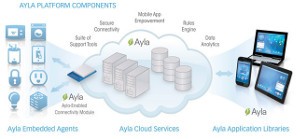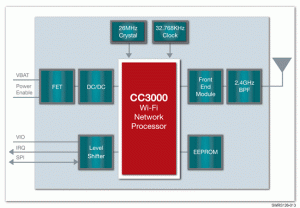In what would seem to be an already crowded marketplace, Ayla Networks have introduced their new agile, cloud-based Internet-of-Things “application enablement” platform that makes it easy and cost-effective for OEMs to connect any of their products or devices to the Internet.
Ayla’s pervasive software creates an adaptive fabric for IoT applications, which aims to accelerate the development and support of smart, interactive product solutions from the device level, to the cloud, to the application level. The Ayla IoT Cloud Fabric combines innovative cloud-based services with powerful software agents integrated into both embedded IoT end-node devices as well as in mobile device applications.
By working closely with Broadcom, Ayla can deliver Embedded Agents supporting Broadcom’s WICED embedded Wi-Fi platform, and Ayla has also partnered with USI to deliver production-ready Wi-Fi Modules incorporating the Ayla Embedded Agent, bringing connected modules and services to market that will allow manufacturers to quickly and economically join the Internet of Things.
The Ayla Design Kit gives you an easy path to get started with securely connecting your product to Ayla’s flexible cloud platform and application libraries. Ayla’s reference design kit provides an out-of-box solution based around an STM32 microcontroller, a Wi-Fi module from Murata pre-loaded with Ayla’s Embedded Agent and a demo mobile app that enables you to quickly get started connecting to Ayla cloud services.
There’s no need to know anything about socket programming or to develop any networking code or learn how to provision a cloud service, because Ayla’s design kit provides you with out-of-the-box Wi-Fi cloud connectivity that is very easy to use.
You can start programming the on-board microcontroller right away, or connect the Wi-Fi development board into your existing microcontroller or the hardware in your product.
Supplied with the Ayla design kit you’ll find microcontroller driver source, demo applications and Ayla’s Application Libraries, which will help enable you to create great apps that securely control your Ayla-enabled hardware with a smartphone or tablet, with support for Android and iOS applications or Web interfaces.
With the Ayla Design Kit, you’ll get an account on Ayla’s Developer Portal, where a simple UI-driven design allows you to build or modify templates for your products in just minutes. Just sign up for a developer account, define a new template, and when you use the same named properties in your design, Ayla will take care of connecting the device and the cloud and keeping them in sync.
The Ayla Design Kit will also give you access to Ayla’s support site, with documentation and how-to guides to assist with your product development, from porting guides for SPI drivers to documentation on connecting to other cloud services through the RESTful APIs that Ayla provides for connectivity with outside services. You can also sign up for a support package that meets your needs.
When you’ve registered your developer and tech support accounts, which are free for users of the Ayla design kit, you can follow Ayla’s online support tutorials to walk through the Design Kit setup process, and you’re ready to get your Design Kit connected to the cloud.
The Ayla platform’s architecture is composed of three primary components – Ayla Embedded Agents, Ayla Cloud Services, and Ayla Application Libraries. Ayla Embedded Agents run on IoT end-node devices or IoT device gateways. They incorporate a fully optimised network stack along with additional protocols to connect devices to Ayla Cloud Services. Developers can choose to use Ayla-supported Wi-Fi networking modules alongside essentially any existing microcontroller in their system.
Ayla Cloud Services are the brains of the Ayla solution. The distributed, cloud-based architecture delivers connectivity with high efficiency, without forcing you into business models requiring ongoing payments. Ayla Cloud Services offer a full suite of intelligence about your product’s performance.
Furthermore, Ayla Application Libraries contain rich APIs for creating apps to securely control Ayla-enabled products with a smartphone or tablet, via iOS or Android native apps or from a web interface.
By abstracting the security and protocol complexity of communicating with the rest of the Ayla platform, Ayla Application Libraries present developers with a virtual device object which is easy to interact with.
When it comes to developing a mobile app, Ayla provides a demo app with the Ayla Design Kit to showcase its cloud-connectivity functionality as well as mobile app libraries to help you create your own Ayla-connected apps, with support for both iOS and Android application development.

With Ayla’s IoT platform you can focus on your UI and customer experience, and leave the platform to take care of the back-end networking, authentication, security and provisioning for you.
The Ayla IoT cloud platform is built for enterprise applications, and it can support your IoT products and applications at any scale. The platform is fully equipped for security, flexibility, operational support, and data analytics – all the capabilities and tools that commercial IoT vendors and developers need to scale their product support at enterprise scales.
And as a leading developer of embedded hardware, IoT products and services from design through to product manufacturing and support – here at the LX Group we have the team, experience and technology to bring your ideas to life.
Getting started is easy – join us for an obligation-free and confidential discussion about your ideas and how we can help bring them to life – click here to contact us, or telephone 1800 810 124.
LX is an award-winning electronics design company based in Sydney, Australia. LX services include full turnkey design, electronics, hardware, software and firmware design. LX specialises in embedded systems and wireless technologies design.
Published by LX Pty Ltd for itself and the LX Group of companies, including LX Design House, LX Solutions and LX Consulting, LX Innovations.


